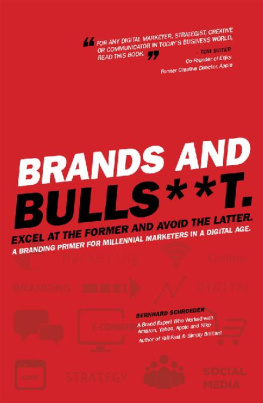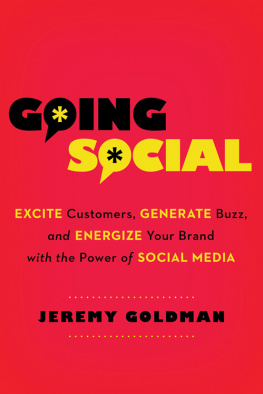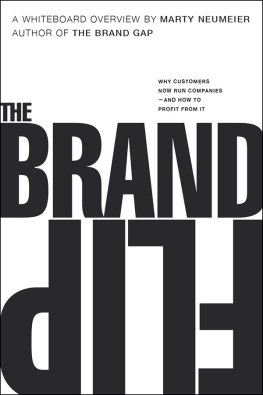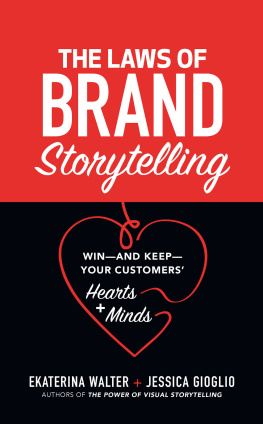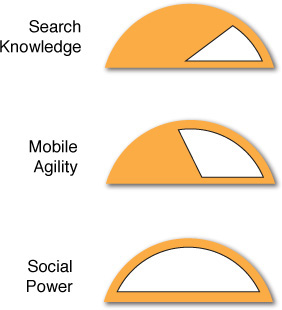1. The Age of the Customer
A tectonic shift is taking place as the economy transforms into the digital economy of the twenty-first century. Clearly visible on the surface, but still not well understood by many brand marketers, is a struggle for power and influence between companies, marketers, and brands on the one hand, and consumers, customers, and their government agencies on the other. We see not-so-subtle symptoms in surprising corners of the corporate world; for example, Microsoft laying off thousands of employees in its mobile phone business, purchased from Nokia only a year agoonce the dominant brand in mobile phones in the early 2000sas Microsoft tries to transform itself from a desktop computer brand into a cloud computing or mobile brand.
We see the struggle too in a faraway corner of the digital world where a lone programmer, Marco Arment, created a mobile app, called Peace, that filtered out mobile ads and personal online tracking on apps and websites. Mobile ads slow down page loads, drain battery power, and waste data bandwidth, and they open the door to malware and fraud. At $2.99 it instantly shot up to #1 in the US Apple App Storewhere it remained for 36 hours. But Marco removed his app just as quickly as he put it up. Why? Because it had the potential to destroy the profit potential of many small (and large) mobile developers and brandsbecause these brands fundamentally rely on mobile advertising. Marco framed his pivotal move in prescient termsas a small but significant cog in a war between consumers and advertisers:
Ad-blocking is a kind of wara first-world, low-stakes, both-sides-are-fortunate-to-have-this-kind-of-problem war, but a war nonetheless, with damage hitting both sides. I see war in the Tao Te Ching sense: it
.
The instant popularity of Peacelike the market success of Uber, Instagram, or Tumblr (also created by Arment)demonstrates the vast market power being accumulated by consumers as they move about with ease in a mobile and nimble world of rapidly changing and disintegrating digital technology. Yet the struggle between marketer and customer is not about technology per sedigital technology is merely an enabler. Consumers dont care whether Apples iOS mobile platform, or Googles Android, or the Windows Phone, or BlackBerry platforms win or lose. Or whether their solution is cloud based, or mobile. What they care about is getting things donesearching, sharing, solving, trying, buyingand achieving the outcomes they want simply, effortlessly, and delightfully. The implications of this shifting mindset for most marketers and brands will be defining and historic, and will be clearly evident within five years.
The Empowered Customer
The thesis of this book is that discriminating customers have never before been as empowered to take control of the customerbrand relationshipdue to the confluence of three transformational market forces (see ).
Figure 1.1 The Empowered Customer
Search Knowledge. Search engines Google, Bing, Yahoo, Ask, or AOL enable customers to effortlessly shop, search, and compare information on any product or servicenew, existing, or obsoleteto obtain replacement parts, to access product information (manuals, operating instructions), and to obtain advice from social message forums, product use forums, and how-to videos on YouTube channels. Because of their search knowledge, customers have the power to demand better performing products and services, and more favorable prices.
Mobile Agility. Mobile platforms such as Apple iOS, Android, BlackBerry, or Microsoft Windows facilitate access to the vast trove of online information regardless of geographic locationon site at retail comparing a retailers prices with other competing retailers, or using GPS to suggest nearby shopping alternatives. Because of their mobile agility, customers have the power to substitute immediate and proximal product and service alternatives, dramatically leveraging their ability to negotiate prices and product/service preferences.
Social Power. Facebook, Google+, Twitter, Reddit, Tumblr, LinkedIn, YouTube, Pinterest, Path, or Pheed enable buyers to share, counsel, blog, seek advice, and engage in social dialogue with persons never before met, simultaneously in nearby and distant places, but with common interests and goals, at this very moment in time. Because they are socially connected, customers have greater power to demand equity and fairness vis--vis other customers in the brand community, and to pose the imminent threat of broadcasting brand failuresas well as brand successes.
These forces are creating a new generation of high-knowledge buyers, who know as much or more than marketers about what it is they are buying. They know more than retail salespersons, more than telephone or chat support representatives, and often know more than the manufacturer or factory marketers themselvesbecause these high-knowledge buyers know of competitors across the global or the local Internet economy that the manufacturer had never thought of. The knowledge of these newly empowered customers affects everything about the way they buytheir price sensitivity, what they value, the type of information they process, the comparative shopping they do, and their expectations for performance, service, and experience.
I had an important wedding anniversary this yearall are important of course, but this one was extra special and I wanted to create a real surprise and buy a new wedding ring. I spent time online to check out the website of a local jeweler that I had done business with over the years, and found a perfect ring. After emailing the webpage to myself, I went to the jewelers retail store to purchase the ring. In store, the saleswoman cheerfully said Of course, do you have the item number? I had better than the item number: I pulled out my iPhone, opened Gmail, and showed her my mobile screen: Here it is right here. This is your webpage with the picture of the ring and its information. The saleswoman went into the backroom and returned with a selection of rings: I cant find that particular one but here is a selection of other rings that look a lot like that one. Really? I explained why this was the ring I wantedit was simply the one. Why dont you just order it, I said. She went into the backroom again, returned and said: That manufacturer no longer lists that ring on their website, but let me research it and get back to you.
She got points for offering to help, but failed in the execution: Their website was wrong, and her selling assumptions were just out of date. I had already spent hours online finding the perfect ringthe type, style, color, carat, clarityand price. Why go through that all over again in a few minutes in the store? She emailed me eight days later saying that she still couldnt find that ring but had found yet another just like it. But I had already gone online again, found my perfect ring at another Internet jewelerfor less money. The ring arrived in two days and the anniversary was a total success. But my customer relationship with that local jeweler will never be the samebecause of the transformational impact of digital. This customer had embraced omni-channel shopping (instant availability through various channels and retailers)with expectations of a seamless experience online, mobile, and in-storeand anticipated immediate satisfaction, even delight. This retailer just had no clue what omni-channel meant, tethered to the old computer in the backroom and trying to sell their limited inventory of in-store rings.


